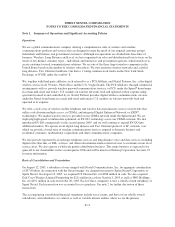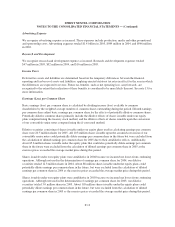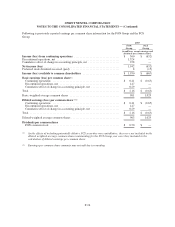Sprint - Nextel 2005 Annual Report Download - page 114
Download and view the complete annual report
Please find page 114 of the 2005 Sprint - Nextel annual report below. You can navigate through the pages in the report by either clicking on the pages listed below, or by using the keyword search tool below to find specific information within the annual report.SPRINT NEXTEL CORPORATION
NOTES TO THE CONSOLIDATED FINANCIAL STATEMENTS — (Continued)
Definite Life Intangibles
Definite life intangibles include the value associated with acquired Wireless subscriber bases, or customer
relationships, the Nextel and Direct ConnectSM trade names and the value of our patents. We evaluate the
recoverability of definite life intangible assets when events or circumstances indicate that these assets might be
impaired. We determine impairment by comparing an asset’s respective carrying value to estimates of the sum of
the future cash flows expected to result from our asset, undiscounted and without interest charges. If the carrying
amount is more than the recoverable amount, a loss is recognized based on the amount by which the carrying
value exceeds the fair value of the asset. Customer relationships are amortized over the estimated customer lives
using the sum of the years’ digits method, which we believe best reflects the estimated pattern in which the
economic benefits will be consumed. All other definite life intangibles are amortized over their estimated useful
lives, using the straight line method.
Derivative Instruments and Hedging Activities
We recognize derivative instruments as either assets or liabilities in the Consolidated Balance Sheets and
measure those instruments at fair value in accordance with SFAS No. 133, Accounting for Derivative Instruments
and Hedging Activities, as amended. Changes in the fair value of derivatives are recorded each period in current
earnings or other comprehensive income (loss) depending on the use of the derivative and whether it qualifies for
hedge accounting.
We use derivative instruments only for hedging and risk management purposes. Hedging activity may be done
for purposes of mitigating the risks associated with an asset, liability, committed transaction or probable
forecasted transaction. We are primarily exposed to the market risk associated with unfavorable movements in
interest rates, equity prices and foreign currencies. We do not enter into derivative transactions for speculative or
trading purposes.
At inception and on an on-going basis, we assess whether each derivative that qualifies for hedge accounting
continues to be highly effective in offsetting changes in the cash flows or fair value of the hedged item. If and
when a derivative instrument is no longer expected to be highly effective, hedge accounting is discontinued.
Hedge ineffectiveness, if any, is included in current period earnings.
We formally document all hedging relationships between the hedging instrument and the hedged item as well as
our risk management objectives and strategies for undertaking various hedge transactions.
Restructuring and Employee Severance Costs
In June 2002, the FASB issued SFAS No. 146, Accounting for Costs Associated with Exit or Disposal Activities.
This standard provides accounting guidance on when a liability for a cost associated with an exit or disposal
activity is incurred. We adopted this standard effective January 1, 2003 for restructuring activities occurring after
that date.
Employee termination benefits to be paid that are not directly associated with restructuring activities are recorded
in accordance with SFAS No. 112, Employers’ Accounting for Postemployment Benefits. Liabilities for
termination benefits to be provided to employees are recognized under SFAS No. 112 when such costs are
probable and estimable.
Debt Financing Costs
We amortize our debt financing costs as interest expense over the terms of the underlying obligations using the
effective interest method.
F-19
























